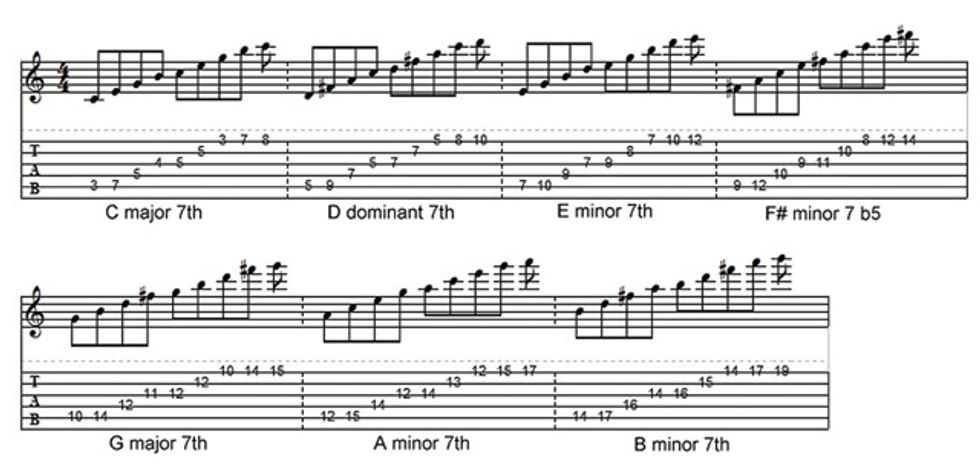Hey guys, welcome back to the continuing saga of “As the Notes Burn.” In this episode Greg Howe decides to put into effect the wisdom of a true mentor and genius by the name of Frank Zappa, whose valuable advice was subtly displayed in text form on the front cover of his 1981 release, Shut Up ‘n Play Yer Guitar.
What will result from having taken such advice? Guess you’ll need to stay tuned in order to find out. But here’s a clue: this month’s episode came awfully close to being entitled “Less Blab, More Tab!”
Okay, so now that you’re finished cheering and celebrating over the implications of that clue, let me briefly preface this stuff by picking up from where I left off.
I vowed to present licks and lines that would not only lend themselves to our ability to execute at high speed, but that would also contain a level of musicality beyond just the delivery of mundane mathematical sequences designed solely for the sake of securing note rapidity.
Yes, we will challenge the popular notion that shred has to happen at the expense of musicality.
Though there are a number of ways to achieve this, I’ll be focusing this month on a method that utilizes the musical concept of superimposing, which is basically the idea of placing one tonality on top of another tonality for the purpose of creating a more complex and colorful new tonality.
This would be like the soloing equivalent to creating chord extensions by essentially playing two chords simultaneously. For instance, if one guitarist played an A minor triad chord while another guitarist played (overlaid) an E minor triad chord, the combined chords would create an Am9 chord.
In the same way, we can imply these expanded tonalities within licks and lines… even at high speed.
I’ve personally found that the easiest way to achieve this is with the use of arpeggios. Simply stated, the arpeggios would, in effect, serve as the overlaying tonality against whatever chord is being addressed.
The following examples are all designed to work within the framework of those modes, keys, and chords existing as a result of the parent key of G major.
In other words, all of these examples will work in a Minor context if the key is A (implying a Dorian tonality); or a Major context if the key is C (implying a Lydian tonality); or a Dominant 7th context if the key is D (implying a Mixolydian tonality).
Note: most of the examples involve the use of 4-note arpeggios that include the 7th as opposed to just triads, and are generally comprised of shapes in which the root note is located on the 5th string. You’ll also find that the examples encourage a very legato-like approach, since the arpeggio shapes really lend themselves to that texture. Also, some examples illustrate the use of multiple arpeggios, or multiple parts of arpeggios within a single lick or line.
The idea here isn’t so much that we’re just playing arpeggios up and down in a blatant fashion, but rather we’re utilizing arpeggio shapes for the sake of forming the foundation of colorful and musical licks or lines, which can then be used effectively at any speed.
My recommendation would be to first play and hear these licks over an A minor chord, then play and hear these licks over a C major chord, and finally play and hear them over a D7 chord. This can be a very useful practice, since the context in which these licks are used will completely dictate the tonal characteristic they take on.
The examples will also technically work with the other modes related to G major, but at the risk of getting into a long and boring harmony discussion, for now I’ll just say they’ll work best in the contexts of the above mentioned. Enjoy!
Watch a video of Greg demonstrating the examples below, or open in a new window:
Click to download printable version of the tab.
 |
| Example 1 These are the 7 arpeggio shapes (based off the G major chord scale) from which some of the licks are designed. |
 |
| Example 2 This example basically utilizes a C major 7th arpeggio. |
 |
| Example 3 This example utilizes an F#min7b5 arpeggio, which is one of my personal favorites to use. |
 |
| Example 4 This example demonstrates the use of the exact same long random sequence used in the previous example, now being applied to an E minor7th arpeggio. |
 |
| Example 5 This example basically combines parts of examples 2 and 3, thus creating a longer lick that features 2 separate superimposed (overlaid) tonalities. |
 |
| Example 6 This example utilizes both an A minor 7th and a B minor 7th arpeggio. |
 |
| Example 7 This example utilizes both an A minor 7th arpeggio and a G major 7th arpeggio. If you get comfortable with this lick, you may want to try attaching example 2 or 4 to the end of it in order to create a much longer lick that would ultimately contain a variety of tonal characteristics. |
Greg Howe
Greg Howe has enjoyed a successful recording career since bursting onto the scene in 1988, and his talents have been sought after by some of the biggest names in the music entertainment industry, such as Michael Jackson, Justin Timberlake, and Enrique Iglesias.

















